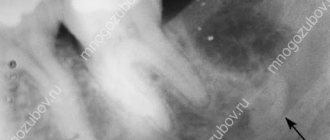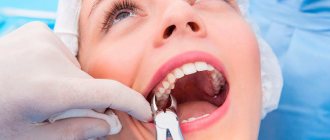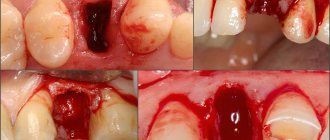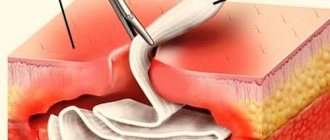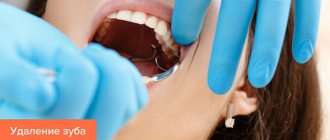Tooth extraction is a very serious procedure, even if it happens quickly and without complications. It always requires increased responsibility on the part of the patient, so it is important to know what rules of care must be followed. The dental surgeon should tell you about them in detail. But to make it easier for you to understand these recommendations, we have systematized them taking into account the specifics of each typical case.
If after tooth extraction the cheek swells and slight swelling appears, then this is considered normal. You should also not be alarmed by mild pain in the tooth socket or an increase in body temperature to 38°C (especially at night). These are all consequences of the inflammatory process. The listed phenomena should disappear on their own after 1-2 days.
Procedure immediately after removal
Tooth extraction is accompanied by a number of activities performed before and after the procedure:
- Do not keep the cotton swab applied by the doctor for longer than 15 minutes. It must be carefully removed so as not to disturb the blood clot. If this is done too late, the wound may become infected, as this is a favorable environment for bacteria to multiply.
- To reduce swelling and relieve pain, apply cold to the cheek, such as ice or frozen food wrapped in a towel. Keep it on your cheek for 5 minutes with constant breaks. Usually 3-5 approaches are enough, but for this, cold water must be applied in the first 4 hours after the removal procedure.
- Sometimes the dentist uses a hemostatic sponge if the bleeding does not stop for a long time. This often happens after wisdom tooth removal. This sponge has an adsorbent, antiseptic, analgesic effect and, in addition, contains the drug alvostasis. It is placed in the hole, and the patient is allowed to perform superficial application only if necessary.
- For severe pain, it is recommended to take painkillers like analgin, tempalgin, spasmalgon, ketanov, ibuprofen, etc. But it is better to consult a dentist about this, since all of the listed medications have a number of contraindications.
- After tooth extraction, you should not drink or eat for 2-4 hours. But it all depends on the complexity of the procedure. So, if several teeth were removed at once or we are talking about a case with suppuration, inflammation or a full-fledged operation with sutures, then this period may be longer. If you really want to drink, you can do this through a straw and in very small sips; optimally, water at room temperature. Under no circumstances should you drink drinks containing alcohol, as it can cause bleeding due to its diluting effect.
- You should not smoke on the day you had a tooth removed, as nicotine has an irritating effect on the tissues of the oral cavity. In addition, each puff involves the formation of a vacuum effect, which poses the risk of dislodging a blood clot and causing a dry socket. If this happens, there is a good chance that you will need medication.
Analogues of the product
There are dozens of types of drugs on the pharmaceutical market that are structural analogues of Nimesil. The similarity of the therapeutic effect and possible side effects on the body of these drugs is due to a single active component - nimesulide. According to reviews from many people, the result of using these drugs is no different from taking Nimesil. Moreover, many analogues are much cheaper than this analgesic.
Examples of medicines that can be used as a substitute for Nimesil:
- Coxtral tablets;
- Aponil tablets;
- Nimegesic tablets and suspension;
- granulate for preparing Mesulide suspension;
- Novolid tablets;
- Nimulid tablets;
- Prolid tablets;
- Ameolin tablets.
This is a partial list of pharmaceuticals. Every pharmacy has several types of structural analogues of Nimesil. Full information about available substitutes for this analgesic can be obtained from your pharmacist.
You cannot independently choose a drug to relieve pain after tooth extraction. Only a dentist can select an analgesic that will have the maximum therapeutic effect and will not cause harm to the body. In some cases (low pain threshold, strong inflammatory reaction), the doctor may prescribe the use of painkillers that contain another active substance, for example, Ketanov.
Home care
After surgery, you can take antiseptic baths on the first day. To do this, you can use furatsilin, chlorhexidine 0.05% or another antiseptic as prescribed by a doctor.
On the second day, you can already brush your teeth using a soft brush. Be careful not to touch the tooth socket, which should still contain a blood clot. After cleaning, you need to rinse the brush in an antiseptic and place it in a sterile place. On the same day, you can take warm baths based on sea salt. To do this, you need to dilute half a tsp. salt in 250-300 ml of water and add 0.25 tsp. soda
Sometimes doctors recommend baths with decoctions for healing. This can be oak bark, elecampane, sage, St. John's wort, chamomile and other plants.
What not to do?
The postoperative period after tooth extraction is 5-7 days. At this time, you need to be attentive to your health, measure your temperature, and monitor for bleeding. If the pain persists for more than 2 days or intensifies (or becomes throbbing), you should contact your dentist.
Over time, healthy tissue forms at the site of the blood clot, but this can be disrupted if the area is not properly cared for. After tooth extraction surgery it is not recommended to:
- Taking anticoagulants because they thin the blood.
- Bathing in a hot bath, visiting a bathhouse and sauna. Sudden changes in temperature can be harmful, as they cause spasms or dilate the lumen of blood vessels. As a result, the pain will intensify and bleeding may resume.
- Rinsing the mouth.
- Drinking alcoholic beverages.
- Smoking.
- Spitting, as this may dislodge the blood clot.
- Treatment of other teeth, including caries, earlier than a week after extraction. As a result, infection can occur, since carious teeth contain many bacteria.
- Strenuous physical activity, especially heavy lifting and bending. This is one of the reasons for increased blood pressure, which serves as a provoking factor for the opening of bleeding.
- Chewing food on the “sick” side of the dentition.
- Active facial expressions. If there are sutures in the oral cavity, they can break and even come apart.
Possible side effects
Like any synthetic pharmacological agent, Nimesil can provoke side effects. The nature of the undesirable reaction and its intensity are determined by the individual characteristics of the body and the presence of pathological changes in the functioning of various organ systems.
Taking Nimesil can lead to the following undesirable symptoms:
- changes in clinical blood parameters (anemia);
- psycho-emotional changes – irritability, anxiety, episodes of nightmares;
- lability of blood pressure or its persistent increase;
- increased heart rate;
- disturbances in the gastrointestinal tract - nausea, vomiting, increased gas formation, constipation or diarrhea;
- dysfunction of the urinary system (urinary retention);
- reduction in visual acuity;
- development of general weakness, drowsiness;
- allergic rashes.
If there are any changes in your health while taking Nimesil, you should stop using the medication and consult a therapist as soon as possible.
Information on the use of drugs
If the procedure was not complicated, it is quite possible that painkillers will not be needed during the recovery period. But it’s better to take an analgesic half an hour before the end of the anesthesia (the doctor will tell you about the approximate time). This will help prevent pain, which is almost inevitable after a complex removal, accompanied by drilling the bone, opening an abscess, cutting out affected tissue, suturing, etc. Drugs such as ketanov, nimesil, nimik, etc. will help you quickly cope with pain. Among other things, they also have an anti-inflammatory effect.
The patient must inform the doctor about his state of health and existing diseases. This is especially important when it comes to arterial hypertension, diabetes, hemophilia, and low platelet levels in the blood. Your dentist should also know if you have a tendency to nosebleeds or have recently had an acute respiratory infection or the flu. In this case, the specialist selects individual methods for caring for the hole.
Contraindications
Nimesil has a fairly large list of contraindications. Therefore, before using the medicine, it is recommended that you familiarize yourself with this list. According to the instructions for the drug, it is contraindicated in the following cases:
- There is hypersensitivity to the active substance (nimesulide)
- Diagnosed with rhinitis, urticaria
- Signs characteristic of bronchospasm are observed
- Have renal and/or heart failure
- The patient is taking other medications that are highly toxic
- Inflammation in the intestines
- Stomach ulcer, bleeding, low blood clotting were diagnosed
- Pregnancy and lactation
- Age up to 12 years
Nimesil is also contraindicated for use in combination with alcohol and drugs.
Elderly patients are advised to take the drug with caution, as it belongs to the NSAID group of drugs.
Features of care after wisdom tooth removal
After the wisdom tooth removal procedure, you must adhere to the same general recommendations regarding socket care.
- Relax
- Do not eat solid food or chew on the area where the tooth was.
- Do not rinse your mouth and try not to spit for 24 hours so as not to dislodge the tampon.
- No smoking for 48 hours
- Don't suck in anything
- Do not create a vacuum in the mouth
For such cases, the recovery period is 2 weeks. At this time, a foreign body may be felt in the hole, since it contains medications for healing and suture material. Often, after the removal of a wisdom tooth, the body temperature rises in the evening. Periodic pain in this area is also considered normal. It is sometimes projected onto the ear and cheekbones.
To eliminate the risk of developing pathologies, you should take antibiotics prescribed by a dental surgeon. Typically, the list of approved drugs includes lincomycin, flemoxin and tsifran. The use of anti-inflammatory drugs such as rotokan and compresses is also recommended. Their effect can be enhanced by applications with agents that prevent the growth of bacteria. Before going to bed and every time after eating, you can do a light and very gentle rinse. In two weeks, all unpleasant consequences should pass. If this does not happen, you should definitely visit the dentist.
Advice for pregnant women
In the case of pregnant women, the list of acceptable analgesics and antiseptic drugs is noticeably reduced. You cannot take medications at your own discretion! They should only be prescribed by a doctor. Also during this period, the use of baths, cold compresses and applications with herbal infusions is allowed.
Method of administration
Nimesil is used for tooth pain only after consultation with a doctor and with his direct participation. One of the main advantages that the medicine has is its release form.
The suspension is prepared from powder according to the instructions
Nimesil is produced in the form of a powder intended for the preparation of a suspension. This solution is quickly absorbed, resulting in relief within 30 minutes. During this period, the concentration of the active substance reaches 50% of the maximum possible.
Before you start using Nimesil, it is recommended that you read the attached instructions. The drug is approved for use subject to a number of conditions:
- The patient's age is over 12 years
- The product is taken only after meals
- The prepared solution is not intended for long-term storage
- The powder is dissolved in half a glass of warm water
The drug is taken daily no more than twice a day. At least 12 hours must pass between each dose.
When do you need to see a doctor urgently?
If a high temperature (more than 38 degrees) lasts longer than a day, and severe swelling is observed, accompanied by an unpleasant odor and taste in the mouth, a doctor’s consultation is necessary. You should immediately see a doctor if the bleeding does not stop for more than 10 hours.
Also reasons to contact a specialist are:
- external signs of seam divergence;
- the appearance of pain in the socket that does not subside for more than 3 days, increasing or pulsating;
- mobility of adjacent teeth;
- numbness of the tongue, cheeks and lips;
- soreness of the submandibular lymph nodes.
Do not ignore the recommendations described above, as this can lead to serious complications and long-term treatment, including in a hospital setting.

